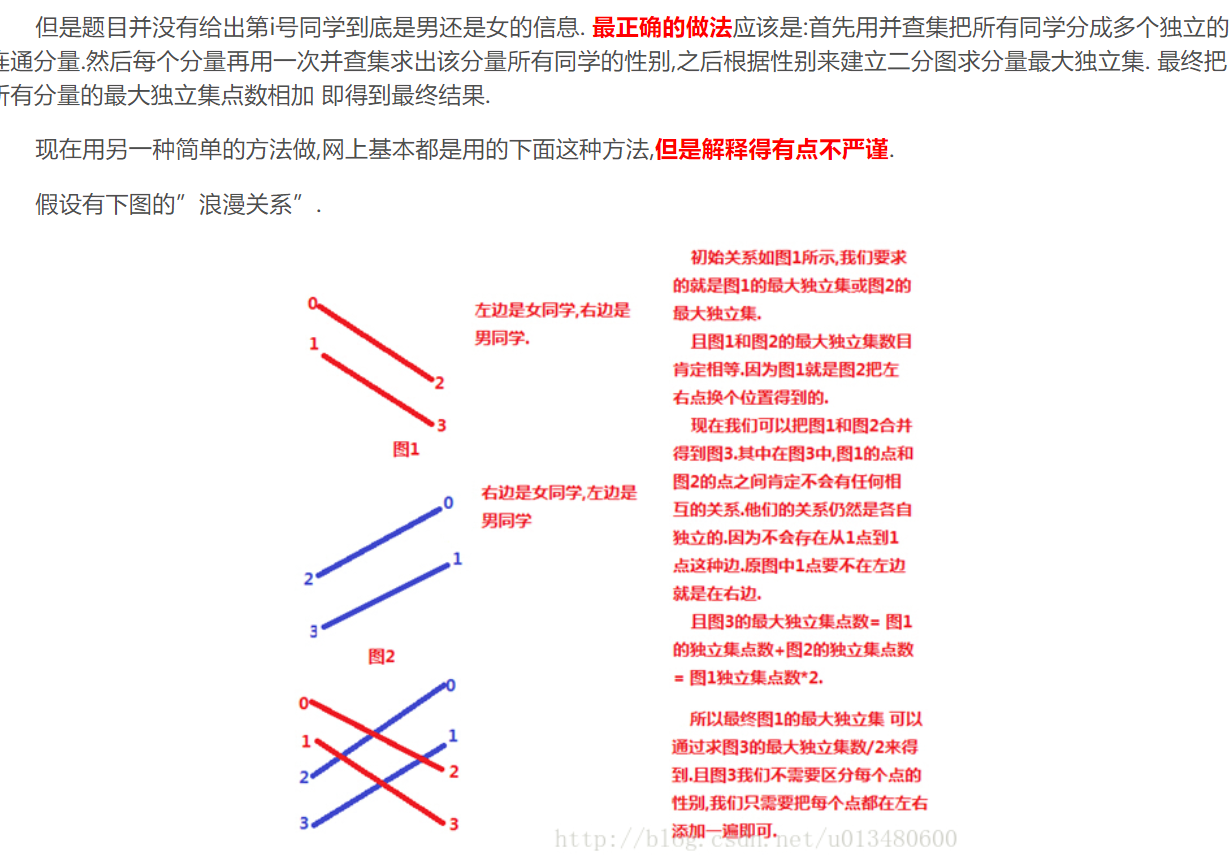hdu1069 Girls and Boys
The input contains several data sets in text format. Each data set represents one set of subjects of the study, with the following description:
the number of students
the description of each student, in the following format
student_identifier:(number_of_romantic_relations) student_identifier1 student_identifier2 student_identifier3 ...
or
student_identifier:(0)
The student_identifier is an integer number between 0 and n-1, for n subjects.
For each given data set, the program should write to standard output a line containing the result.
Input
7 0: (3) 4 5 6 1: (2) 4 6 2: (0) 3: (0) 4: (2) 0 1 5: (1) 0 6: (2) 0 1 3 0: (2) 1 2 1: (1) 0 2: (1) 0
Output
5 2
Sample Input
7 0: (3) 4 5 6 1: (2) 4 6 2: (0) 3: (0) 4: (2) 0 1 5: (1) 0 6: (2) 0 1 3 0: (2) 1 2 1: (1) 0 2: (1) 0
Sample Output
5 2
匈牙利算法是由匈牙利数学家Edmonds于1965年提出,因而得名。匈牙利算法是基于Hall定理中充分性证明的思想,它是部图匹配最常见的算法,该算法的核心就是寻找增广路径,它是一种用增广路径求二分图最大匹配的算法。
-------等等,看得头大?那么请看下面的版本:
注:以下转自 http://blog.csdn.net/dark_scope/article/details/8880547
通过数代人的努力,你终于赶上了剩男剩女的大潮,假设你是一位光荣的新世纪媒人,在你的手上有N个剩男,M个剩女,每个人都可能对多名异性有好感( -_-||暂时不考虑特殊的性取向),如果一对男女互有好感,那么你就可以把这一对撮合在一起,现在让我们无视掉所有的单相思(好忧伤的感觉
-_-||暂时不考虑特殊的性取向),如果一对男女互有好感,那么你就可以把这一对撮合在一起,现在让我们无视掉所有的单相思(好忧伤的感觉 ),你拥有的大概就是下面这样一张关系图,每一条连线都表示互有好感。
),你拥有的大概就是下面这样一张关系图,每一条连线都表示互有好感。
本着救人一命,胜造七级浮屠的原则,你想要尽可能地撮合更多的情侣,匈牙利算法的工作模式会教你这样做:
===============================================================================
一: 先试着给1号男生找妹子,发现第一个和他相连的1号女生还名花无主,got it,连上一条蓝线
===============================================================================
二:接着给2号男生找妹子,发现第一个和他相连的2号女生名花无主,got it
===============================================================================
三:接下来是3号男生,很遗憾1号女生已经有主了,怎么办呢?
我们试着给之前1号女生匹配的男生(也就是1号男生)另外分配一个妹子。
(黄色表示这条边被临时拆掉)
与1号男生相连的第二个女生是2号女生,但是2号女生也有主了,怎么办呢?我们再试着给2号女生的原配(
 )重新找个妹子(注意这个步骤和上面是一样的,这是一个递归的过程)
)重新找个妹子(注意这个步骤和上面是一样的,这是一个递归的过程)
此时发现2号男生还能找到3号女生,那么之前的问题迎刃而解了,回溯回去
2号男生可以找3号妹子~~~ 1号男生可以找2号妹子了~~~ 3号男生可以找1号妹子
所以第三步最后的结果就是:
===============================================================================
四: 接下来是4号男生,很遗憾,按照第三步的节奏我们没法给4号男生腾出来一个妹子,我们实在是无能为力了……香吉士同学走好。
===============================================================================
其原则大概是:有机会上,没机会创造机会也要上.
这是匈牙利算法的理解;
然后再看这道题;

#include <stdio.h>
#include <string.h>
int book[10010];
int match[10010];
int y[1010][1010];
int n;
int yue(int u) //匈牙利算法
{
int v,i,j;
for(i=1; i <= n; i++){
if(book[i] == 0 && y[u][i] == 1){
book[i]=1;
if(match[i]==0||yue(match[i])){
match[i]=u;
return 1;
}
}
}
return 0;
}
int main()
{
int i,j,k,a,b,m;
while(scanf("%d",&n)!=EOF)
{
memset(y,0,sizeof(y));
memset(match,0,sizeof(match));
for(i=0;i<n;i++){
scanf("%d: (%d)",&a,&m);
while(m--){
scanf("%d",&b);
y[a+1][b+1]=1;
}
}
k=0;
for(i=1;i<=n;i++){
memset(book,0,sizeof(book));
if(yue(i)==1)
k++;
}
printf("%d\n",n-k/2); //因为这道题(1,2)跟(2,1)是一样的,所以k得除以2;
}
return 0;
}










